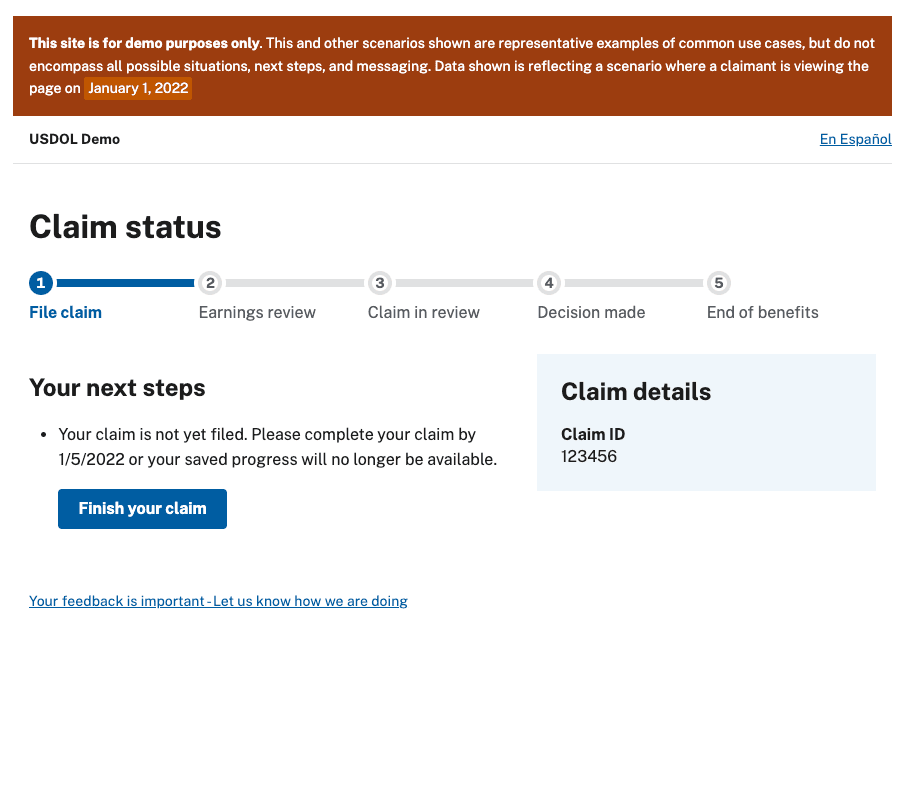Summary
For millions of Americans, unemployment insurance (UI) can be the difference between staying afloat and falling through the cracks. In fact, one in four workers relied on unemployment aid during the pandemic. But those workers had to jump through hoops, like jammed phone lines and crashing state websites, to get the support they needed. The pandemic exposed a long standing need for modern unemployment insurance services. Nava is honored to work with the U.S. Department of Labor (DOL) as they support states, territories, and the public to develop strategies to continuously improve the nation’s UI system. This $1 billion mandate, sparked by the COVID-19 pandemic, will help us better prepare for the next economic shock.
- 170 government employees from
-18 states engaged with the claims transparency playbook
Nava’s role in this effort is to support DOL with product management, content design, service design, and interaction design. Together with states, we're developing strategies and resources that states can use to detect and prevent fraud, ensure timely payment of benefits, and expand access to UI.
Most of the inquiries and calls that state workforce agencies receive from claimants are about the status of their payments, which is why the Department wanted to make it easy for state agencies to proactively and accurately answer these questions. Similar to a food delivery app that tracks where your order is, a claim status tool can help communicate to UI claimants where their unemployment claim stands. Claim status tools can help reduce administrative burden for agency staff that field claimants' questions and calls. Proactively and accurately answering these questions can also go a long way in building trust with people who are urgently seeking help.
One of DOL’s main initiatives that we’re supporting has been developing a claim status playbook, which offers detailed instructions and best-practices on how to build a claim status tool. The playbook is complemented by a coded prototype of a hypothetical UI claim that serves as an example for states building their own claim status tool.

Approach
Each state has different capabilities, policies, and needs when it comes to UI. That’s why the team set out to understand how to make a claim status playbook and prototype that would be useful and customizable for all states.
The team began with research and turned to UI experts at the state and federal levels, as well as stakeholder groups focused on improving UI services across the country. Next, the team rapidly prototyped the playbook—meaning they built a “first draft” version—got feedback on the draft, and then refined the prototype. Throughout it all, The Department focused on this broad question: Will clearer and more actionable claim statuses make it easier for people to apply for and receive UI, lower call center volumes for the states, and reduce confusion for the claimants?
These meetings led to several important learnings. For example, the coded prototype displays eight common scenarios of what it can look like for someone to advance through a claim. The Department’s stakeholders helped the team understand which types of UI scenarios would be most common for states, since they couldn’t address every potential scenario with the prototype. Some of these scenarios include a claimant who is being reviewed for financial eligibility and a claimant who must verify that they’re able and available to work. Prioritizing common UI scenarios helped us shape the prototype in a way that would be most impactful and useful for the most possible states. To expand access to this resource, the team translated each scenario into plain language Spanish.
Outcomes
We spoke with staff from multiple states, as well as The Department’s stakeholders who previously worked in state agencies, to gain an understanding of what state agencies might be looking for in a claims status playbook. Split into three sections, the playbook offers end-to-end guidance for states that want to undertake a claim status project while improving the claimant experience and internal operations processes. It also includes examples of an effective claim status experience and practical strategies states can adopt to meet the needs of claimants.
The playbook begins with a “Getting started” section that outlines what states should consider when beginning a claim status project. Specifically, this section emphasizes ways to ensure that the project meets a state’s existing or future needs. It contains detailed guides for states on defining objectives, prioritizing the claim status project, and setting up timelines and operations.
After states have established their needs and goals, they can utilize the playbook’s “Assess and plan” section. This section breaks down identifying stakeholders for a project, establishing metrics to assess performance, evaluating processes, and determining and defining scope upfront.
Finally, the “Implement” section discusses how to implement specific areas within a claim status project. These areas are improving claims processes, improving quality and availability of data, incorporating a claim status tool into a legacy system, creating an integrated notifications system, communicating with claimants in a user-friendly way, and creating a claimant-friendly status tool.
In addition to the claim status playbook, the team developed a mobile usability guide to help states improve their UI mobile experiences. To build this guide, the team began by researching the mobile usability of several existing UI claimant portals and assessing what works and what doesn’t. They then developed the guide, which offers human-centered tips for improving layout, type and text, and form design on mobile. These tips are accompanied by wireframe examples—or blueprints of mobile pages—that demonstrate common mobile usability issues in UI and how to address them.
Process
The Department recognized that a playbook alone is not enough to make a change–a well-rounded strategy to support, partner, and fund state workforce agencies is also required. The team engaged states across the nation with the playbook to help them start their claim status tool modernization journey.
In an effort to make states aware of this work, the team supported communications efforts by the Department to share this playbook with state workforce agencies nationwide, highlighting the benefits of having a modernized status tool and the grants available for states to fund their projects. These communications materials also highlighted the role that DOL would play in providing technical assistance to states as they undergo modernization projects.
The team also worked with The Department to host and market an information session on improving claim status communications. In total, over 170 government employees joined the session from 18 different states. This demonstrated that states want to learn about ways to modernize their public services through features like claim status tools, and that playbooks are a useful tool to drive human-centered modernization. DOL has given grants to states to improve their benefits processes and technologies. The resources developed in this project will be a powerful tool to fuel those efforts.
Closing summary
A human-centered playbook has the potential to support states as they embark on claim status projects, ultimately benefiting claimants and state agency staff. However, the team knew the playbook had to be paired with a robust communication strategy to achieve the most impact. By continuously engaging with and soliciting feedback from stakeholders, the team was able to support DOL in developing a playbook that meets states’ needs while making states aware of this crucial resource. Most importantly, the success of the playbook, the engagement strategy, and information session proved that this is an effective way to share content that is relevant to states and to spur mission-critical modernization efforts.
Written by

Product manager

Product manager

Senior Editorial manager
